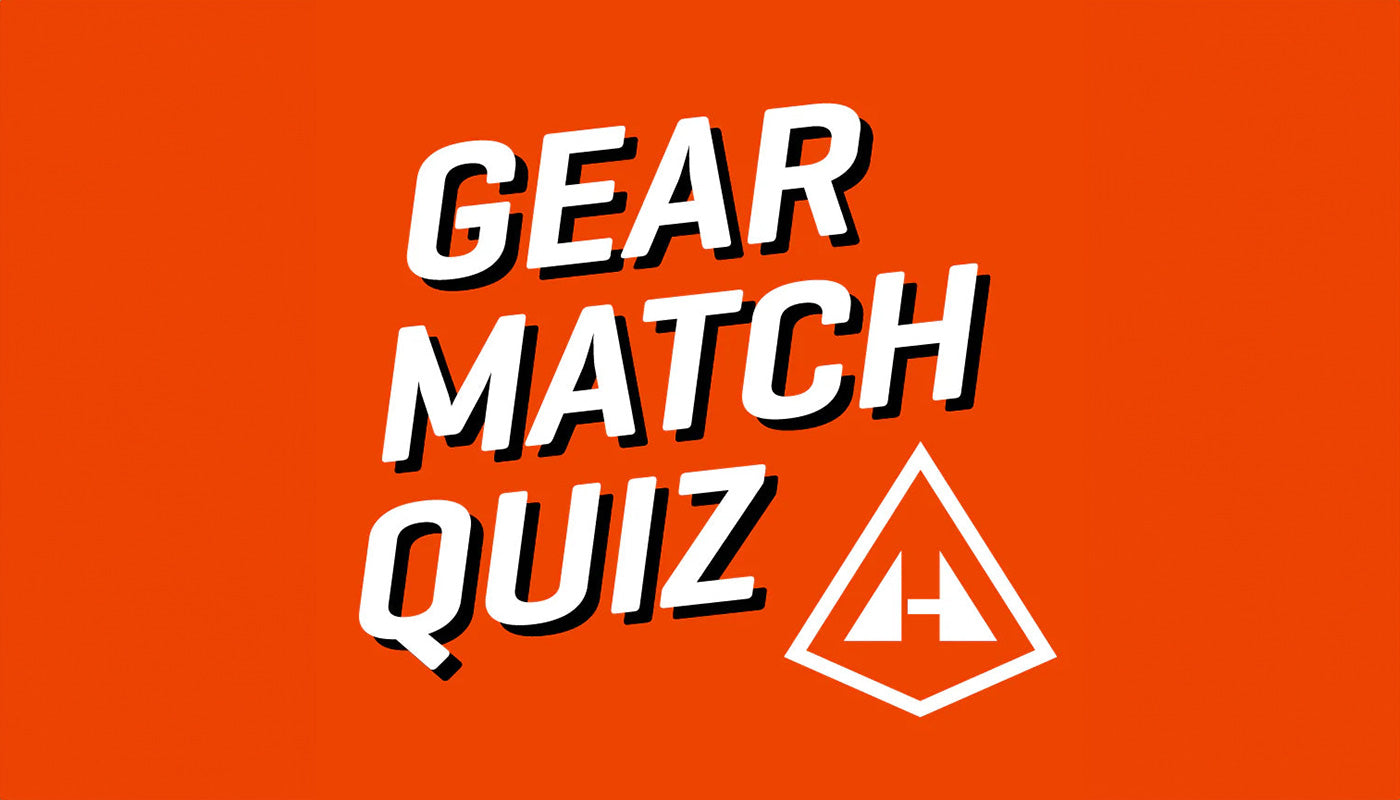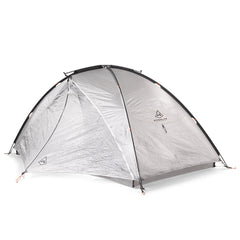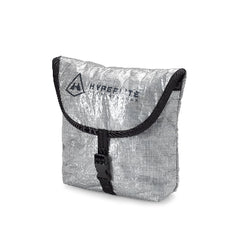From pyramids to tarps to as-of-yet-unnamed geographic shapes, there are plenty of options and degrees by which you can protect yourself from the elements. At their core, that’s a shelters most basic job. But there are other less tangible effects of having a great mobile space; familiarity, comfort, livability, and even in a “can’t-see-me-if-I-can’t-see-you” kind of way, security from creatures of all shapes. Ease of use, durability, and the ability to get safe quick also heighten the shelter/owner relationship, and a strong bond can alleviate a lot of trepidation as you venture deeper into the unknown. There are compelling arguments for a wide variety of shelters, so we’ll let our panel here give their pitches.
MIKE ST. PIERRE
HYPERLITE MOUNTAIN GEAR // CO-FOUNDER + CEO
There are many high-quality tents on the market, but most are just too heavy for ultralight backpacking. I prefer Dyneema® Composite Fabric shelters as they are extremely lightweight and will keep you much drier than any woven and coated fabric like silnylon or any PU coated fabric.
Our Hyperlite Mountain Gear Shelters + Tents check off all the boxes because they’re extremely lightweight, very strong in high winds, easy to set up, and very waterproof. With DCF fabrics you don’t need to worry about touching the wall inside like you do with coated traditional shelter fabrics.
“THE BASIC DESIGN OF A TIPI OR PYRAMID-STYLE TENT HAS BEEN AROUND FOR MILLENNIA. FOR GOOD REASON: THEY ARE EASY TO SET UP, REMARKABLY DURABLE, AND USE SPACE EFFICIENTLY.” // FORREST MCCARTHY – MID-LIFE IS WONDERFUL: PYRAMID TENT HISTORY
STAKES: THE DIFFERENCE BETWEEN HOLDING DOWN THE FORT, AND CHASING IT
Can a backpacker be passionate about these humdrum items? Yes. There’s a lot at, wait for it… at STAKE without them. Couldn’t help it. They’re critical for pitching your shelter, can end up being a perfect tool in situations you haven’t imagined yet, and, if designed and constructed properly, they’re just as effective in their lightest possible form. These are crucial pieces of gear you don't want to skimp out on.

BETHANY "FIDGIT" HUGHES
THRU HIKER // WORLD TRAVELER // HER-ODYSSEY.ORG
My hiking partner and I used the UltaMid 2 Pyramid Tent while thru hiking Patagonia. We both have tall torsos so were delighted to find a tent with both the head room and floor space for us to both be comfortable. The vestibule was ample, and the various inserts allowed us to adapt to the conditions (bug net or no?)

LUC MEHL
PACKRAFTER // EXPLORER // ALASKAN GEAR // THINGSTOLUCAT.COM
I take a fairly calculated approach to shelters, but for 0-0.5 lb per person in summer low exposure scenarios, my preference is the Echo 2 Shelter System. I’ve set it up with skis, sticks, bicycle wheels, and paddles. I really appreciate the bug insert and waterproof floor.

TYLER "WATER BOY" COSGROVE
THRU HIKER // PHOTOGRAPHER // @TYLERCOSGROVE92
As far as shelters go, the Hyperlite Mountain Gear Square Flat Tarp is my go-to. As long as it’s not raining, I prefer to cowboy camp and sleep with no shelter. For that reason, carrying the extra weight of a tent with all the bells and whistles (mosquito nets and zippers) just to set up on occasion doesn’t make sense for me. The Flat Tarp quick and easy setup and it’s saved me multiple times when I’ve been overconfident in the weather and awoke to raindrops hitting my sleeping bag.

HANSI JOHNSON
OUTDOOR ADVOCACY SPECIALIST // PHOTOGRAPHER // @HANSSKI43
I've used the UltaMid 2 Pyramid Tent for an entire season in Alaska and Boundary Waters Canoe Area. It's Ultralight, ultra-protective, simple, easy to pack, and holds up any weather I've been able to throw at it. Basically, it saved my ass on a recent photo shoot and fishing trip in Alaska for The Drake magazine. Rained the entire trip. I was the only dry one of my group, and I never worried about my photo equipment because the shelter was totally waterproof.

MIKE CURIAK
EXPLORER // PHOTOGRAPHER // WHEEL BUILDER // MIKESEE.EXPOSURE.CO
I'm a minimalist in more ways than one, meaning I don't have a shelf full of shelters to choose from at any point. Of the shelters that I do own, I want them to be as light as possible, but they MUST be versatile across different activities and seasons. The shelter that I know, use, and trust more than any other is the UltaMid 4. I use it on solo missions because I like having the extra space to junk show gear or put a fat bike inside when the weather goes south. I've used it in all four seasons, from arctic Alaska to Death Valley, on snow, beach sand, high in the mountains, and when hunkered down during desert monsoons. I do own other shelters, but the UltaMid 4 is my quiver killer and the one that gets used more than all the others combined.

KRYSTIAN "SNAP" REPOLONA
THRU HIKER // PHOTOGRAPHER // @HIKES.CAMERA.ADVENTURE
I use the UltaMid 2 shelter with either the full insert with flooring or half insert depending on environment considerations and whether I will be sharing the shelter with someone. On the Appalachian Trail, I previously used a freestanding tent made of silnylon and was dissatisfied with its wet weather performance. The silnylon would eventually wet out and start sagging/stretching requiring you to retighten the guylines for a taut pitch. Any thru hiker can attest that packing a soaking wet tent sucks. With the UltaMid 2 being made of DCF, water always beads on the surface, so it is super easy to shake off water or give it a quick pat down with a cloth before rolling it away. And it results in much less unnecessary water weight for you to carry.
Another thing I love about the UltaMid 2 is how much room it has inside. It’s a palace for two and a kingdom for one. One of my most memorable experiences with the shelter was while I was camped out on top of the Bigelows along the AT in Maine. I set my sleeping stuff up inside the base of the old fire tower that used to be there. I turned in that night not expecting any rain since there was cell reception up there and I was able to see a rain-free weather forecast. Two hours of shut eye later, I woke up to rain falling on my face that gradually gathered intensity. I crawled out of my sleeping bag and initially thought “FML,” forgetting that I still had my Ultamid 2 in my pack. With no great way to set up the shelter at the base of the fire tower and ever-increasing rain, I decided to just “burrito myself in my sleeping set-up. By the time I rolled myself up it was a torrential downpour and I lay awake for about an hour wondering if I would be able to stay dry. Finally, an hour later, the heavy rain subsided, and it never rained again. The Ultamid 2 saved me that night.

JOE CRUZ
BIKEPACKER // WRITER // EDITOR @ BIKEPACKING.COM // JOECRUZ.WORDPRESS.COM
Tarp camping requires a change in attitude. I know. Often when people in the ultralight community say that about a piece of gear, they’re trying to apologize for something that is light but doesn’t work very well. I promise, I’m no tarp evangelist, I spend plenty of time in my Big Agnes Fly Creek HV UL1. But the most versatile, lowest weight, most compact, and most satisfying backcountry shelter is a square flat tarp.
The change in attitude has to do with embracing the idea that putting up shelter requires and is an expression of skill and experience. That’s not to say that I’m particularly expert at tarpcraft, quite the contrary. But I’ve found it a pleasure to learn about and practice different tarp setups. It’s distinct from just learning the setup of a tent that more or less goes the same way every time. The satisfaction of skillful execution (in anything!) is a potent source of happiness. Putting up a tarp calls on knowledge of various pitches, a sense of ground conditions, and an eye for setup affordances. There’s some creativity involved, too. In my view, that chance to realize mastery is its own kind of reward. Go ahead and youtube “tarp pitches.” Enjoy the next few hours and take notes for when you can practice outside.
One tricky thing is that bikepackers don’t travel with walking sticks, while many venerable tarp pitches assume that you do. There are three kinds of solutions, and all of them might be in a play in a single trip. One can pitch with just cordage, yielding standard A frames, lean-to’s, tube setups, or pyramids with an anchor point above. Or one can bring along a carbon pole or two. Or one can find a stick or several of the right size. I usually pack the pole to make things easy on myself.
The square (8’6” x 8’6”) Flat Tarp is plenty big to protect me and some gear. It’s not unusual for the tarp shelter to be become the impromptu gathering place for the team for a card game or to wait out the morning pouring rain. Folded up, it disappears.

JESSICA KELLEY
BIKEPACKER // PACKRAFTER // @JESSI_GOES
I took the Ultamid 2 with me for a 1,350-mile bikerafting trip around Alaska and it was amazing - my own little home away from home for three-plus weeks. It was awesome to have so much space to spread out and dry my gear. I almost felt embarrassed to pitch such a big tent for just one person! But then I crawled into it and was so warm, dry, and comfortable that I completely forgot about being embarrassed.

LIZ "HANDSTAND" KIDDER
THRU HIKER // WORLD TRAVELER // @LIZKIDDER
I started off my thru hike with the Echo 2 Shelter System. I love this tent because it is super lightweight, it uses the trekking poles to set it up, it’s dual-walled so there’s little-to-no condensation, and it looks super cool! I always got compliments on it! There’s a little bit of a learning curve in setting it up, but once you get it down, it’s super easy and quick! It was really spacious inside, plenty of room for me and to lay out all of my stuff – something was especially nice when I had a bunch























